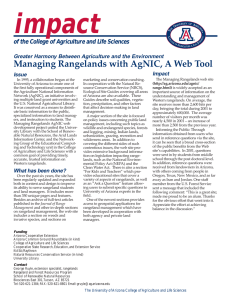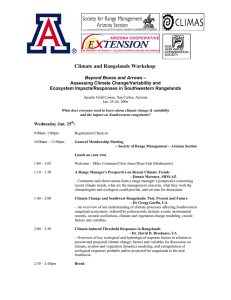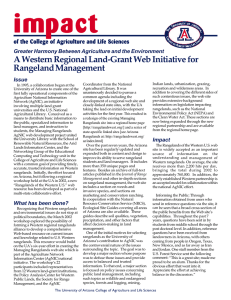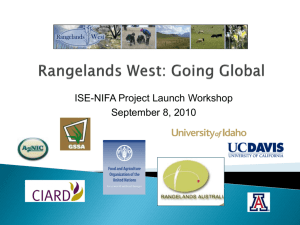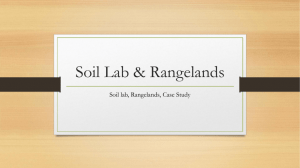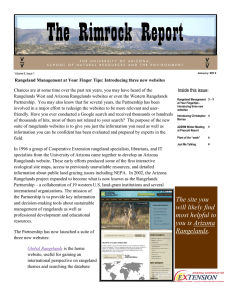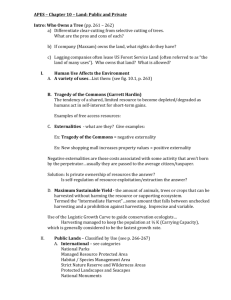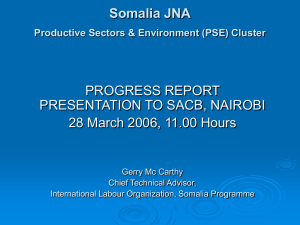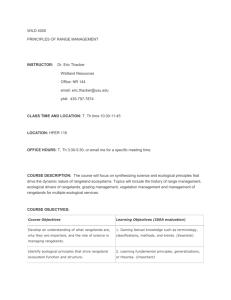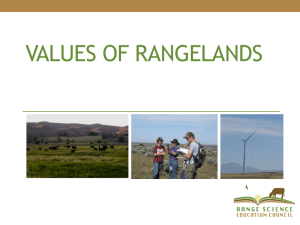The Rimrock Report
advertisement
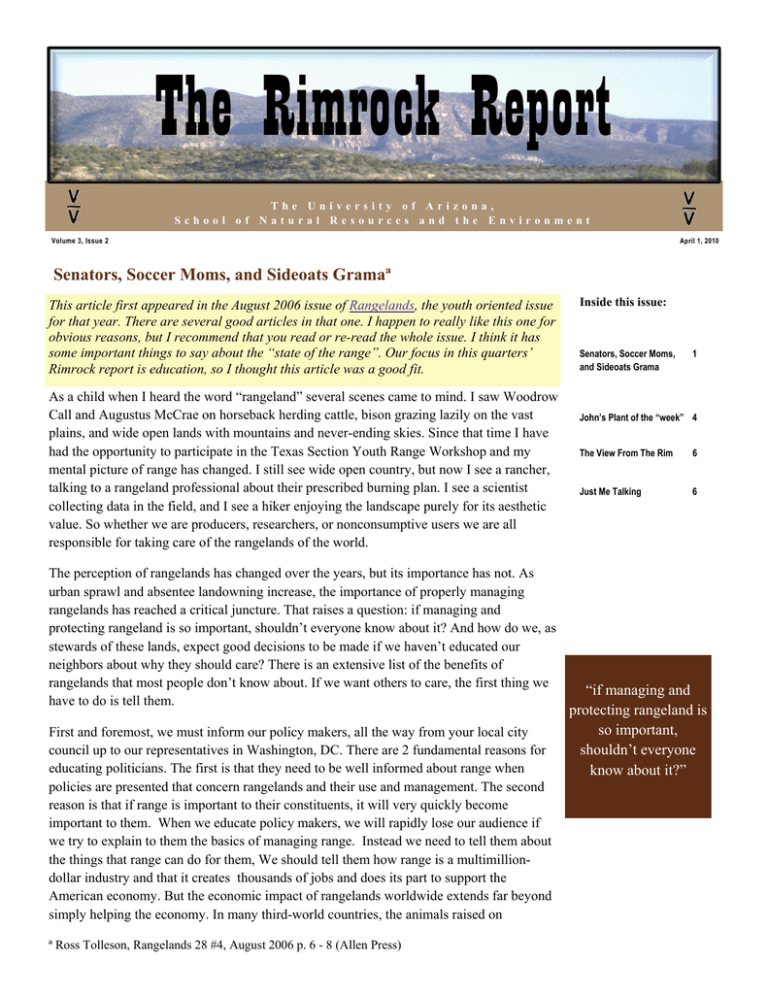
The Rimrock Report The University of Arizona, School of Natural Resources and the Environment Volume 3, Issue 2 April 1, 2010 Senators, Soccer Moms, and Sideoats Gramaª This article first appeared in the August 2006 issue of Rangelands, the youth oriented issue for that year. There are several good articles in that one. I happen to really like this one for obvious reasons, but I recommend that you read or re-read the whole issue. I think it has some important things to say about the “state of the range”. Our focus in this quarters’ Rimrock report is education, so I thought this article was a good fit. As a child when I heard the word “rangeland” several scenes came to mind. I saw Woodrow Call and Augustus McCrae on horseback herding cattle, bison grazing lazily on the vast plains, and wide open lands with mountains and never-ending skies. Since that time I have had the opportunity to participate in the Texas Section Youth Range Workshop and my mental picture of range has changed. I still see wide open country, but now I see a rancher, talking to a rangeland professional about their prescribed burning plan. I see a scientist collecting data in the field, and I see a hiker enjoying the landscape purely for its aesthetic value. So whether we are producers, researchers, or nonconsumptive users we are all responsible for taking care of the rangelands of the world. The perception of rangelands has changed over the years, but its importance has not. As urban sprawl and absentee landowning increase, the importance of properly managing rangelands has reached a critical juncture. That raises a question: if managing and protecting rangeland is so important, shouldn’t everyone know about it? And how do we, as stewards of these lands, expect good decisions to be made if we haven’t educated our neighbors about why they should care? There is an extensive list of the benefits of rangelands that most people don’t know about. If we want others to care, the first thing we have to do is tell them. First and foremost, we must inform our policy makers, all the way from your local city council up to our representatives in Washington, DC. There are 2 fundamental reasons for educating politicians. The first is that they need to be well informed about range when policies are presented that concern rangelands and their use and management. The second reason is that if range is important to their constituents, it will very quickly become important to them. When we educate policy makers, we will rapidly lose our audience if we try to explain to them the basics of managing range. Instead we need to tell them about the things that range can do for them, We should tell them how range is a multimilliondollar industry and that it creates thousands of jobs and does its part to support the American economy. But the economic impact of rangelands worldwide extends far beyond simply helping the economy. In many third-world countries, the animals raised on ª Ross Tolleson, Rangelands 28 #4, August 2006 p. 6 - 8 (Allen Press) Inside this issue: Senators, Soccer Moms, and Sideoats Grama 1 John’s Plant of the “week” 4 The View From The Rim 6 Just Me Talking 6 “if managing and protecting rangeland is so important, shouldn’t everyone know about it?” The Rimrock Report Senators, Soccer Moms and Sideoats Grama...continued rangelands are the primary source of income, and having healthy rangelands provides economic and often political stability because a country with a stable economy and a steady food supply is much less likely to feel the need to invade its neighbor. So, in some parts of the world, properly managed rangelands can help to create peace. In addition to the economic importance of rangelands, we should also inform politicians about the role that rangelands play in the environment. Many states are currently having water shortages. Rangelands, when managed properly, are a vital part of aquifer recharge. The rainwater that falls on rangelands goes not only into the plants, but to aquifers as well. Rangelands additionally provide oxygen to the atmosphere through the photosynthesis of the plants present. With the rising concern of air pollution, oxygen replacement and carbon sequestration will make rangelands an invaluable resource that politicians will quickly recognize. However, simply educating politicians is Clean water is just one of the goods and services to result from good not enough. range management. We must also educate voters. Very few things that we can tell a senator will have as much impact as letters from soccer moms or other voters. Therefore we must also educate the voters because if they don’t care, it isn’t likely that politicians will either. Just as politicians are concerned with the economy, voters are concerned with family. Logic dictates, then, that we would present to voters all the reasons why rangelands are important to their family. Most people are concerned with the water shortages and just, as we told the politicians, rangelands are vital to combating that crisis, but to people who are not experiencing a shortage the quality of their water becomes important. Rangelands catch the majority of the water that goes into the aquifers and as that water seeps through the ground it is filtered naturally, leaving behind many of the pollutants gained while in the atmosphere. Clean water is very important to people with children. And once again the clean air produced from rangelands carries weight with voters. Besides clean air and water, the food supply is a significant issue to voters. Rangelands are primarily used for livestock . The animals raised on these lands provide food for voters and their families, which makes them imperative. But rangelands provide more than just crucial services to voters. They also provide recreational opportunities. Rangelands are also commonly used for recreational enterprises, most often hunting. The experience of taking a son or daughter on a hunting trip and spending that quality time together is just as valuable to some voters as clean air and water. For those who choose not to hunt, other options exist. Camping and hiking are also activities valued by many voters. Similarly, ecotourism has steadily become a preferred pastime. Bird watching, wildlife photography, and plant identification constitute an increasing amount of the usage of rangelands. No matter what the voters are interested in, rangelands are somehow involved in their everyday life. So it is our job to help them understand their worth. Without the support of voters, making the case for range will not be an easy task. Page 2 The Rimrock Report Senators, Soccer Moms and Sideoats Grama...continued A recent topic of concern to voters and policy makers alike is the recent outbreak of wildfires. These fires have affected the forests and rangelands of many western states and have also destroyed many homes and businesses. The public’s perception is that fires are bad and we should work hard to prevent them with burn bans. Though burn bans are sometimes needed they are very often misused. What people don’t realize is that sometimes you have to fight fire with fire. Using a technique known as “prescribed burning,” range professionals are able to minimize the number and scope of wildfires. A prescribed burn is exactly what it sounds like; fires are set in pastures and forests in a controlled and planned way. The benefits of the fires are twofold, benefiting rangelands and homeowners at the same time. The pastures and forests benefit because the fire promotes regrowth and clears out the detrimental plants from the landscape. Homeowners benefit because those controlled fires eliminate the fuel load around their home or place of business. Changing the perception of fire is vital to the future of rangelands and the safety of suburban residents. The question now is: Why? Why should we educate senators and soccer moms, politicians and voters? The answer: sideoats grama, the rangelands themselves. If voters and policy makers understand and appreciate the value of rangelands they will be more likely to vote and act in favor of policies that will benefit rangelands, such as current legislation before Congress concerning the use of fire as a management tool. Finally, we should educate policy makers and their constituents to ensure the future of rangelands. Not only for the people that it benefits, but also for the people that have made preserving it their career, their passion. Organizations such as the Society for Range Management have taken steps in the right direction by Future range managers hone their plant ID skills at the V Bar V organizing so that all of the best in the business can collaborate and learn from one another and improve and maintain our rangelands. Now it is up to us to do our part in preserving the rangelands of the world, which is work worth doing. Woodrow Call and Augustus McCrae made their journey long ago and many things have changed, but the vast expanses of range over which they traveled are not gone. But to ensure that the next generation will continue to have these same rangelands we must effectively manage them. But if only people who know about range and how to manage it are the ones in the business, it does us little good. We have to educate policy makers and voters so that they will appreciate and help protect rangelands; in order to do that we have quite a bit of work ahead of us. But Teddy Roosevelt said it like this, “Far and away the best prize that life offers is the chance to work hard at work worth doing.” Page 3 Volume 3, Issue 2 John’s Plant of the “week” I was 10 years old when a Sunday afternoon drive an hour east of our farm ended at Maplewood State Park. It was fall and the trees were turning colors. The colors I saw that day were so different from the yellow of the cottonwood, boxelder and ash growing around our farm. The Maple leaves were not just yellow but every color between green and brown. I was enthralled. My mother encouraged me to collect leaves of different shapes and colors. When we got home we found some old plywood squares, newspaper and cardboard. We layered the leaves inside and placed the stack near the furnace to help the drying process, weighing it down with several encyclopedia volumes. Several days later we opened it up and had neatly pressed leaves as memories of our trip. Collecting plants has become a hobby for me, perhaps started on that trip to Maplewood State park, but one I picked up again in graduate school. I carried my plant press and notebook with me on all my research trips and often on weekend drives. I would collect plants I knew, and plants I did not know. My records indicate purple locoweed, Oxytropis lambertii, as the first plant I collected. The 146 species I collected in graduate school are now part of the North Dakota State University herbarium. The purpose of this article is to detail how to collect plants. A collection of pressed, identified and labeled plant specimens is called an herbarium. As land managers it is important to have a record of plants found on the land and an herbarium is an excellent way to keep plant records. The earth is a changing place and recording these changes is essential and can be used to evaluate or direct management decisions. Where you collect is as important as what you collect. Ideally plants are collected along with other monitoring done on the land. If key areas are monitored on a regular basis, this is a good place to start. If monitoring is done with agency personnel, the potential of someone knowing each plant increase, decreasing the identification process later. If you don’t have a plant press in the field, a large plastic sealable storage bag with moistened paper inside is adequate for storage of plants until they can be put into a press. Sometimes putting this bag in the refrigerator will reinvigorate the plants prior to placing in the press. A plant press can be as simple as a couple of pieces of ½ or 5/8 inch plywood cut to a size of 12x18 inches. Between the plywood you will need several pieces of cardboard cut to the same size. Between the two pieces of cardboard place your collected plant into the fold of old newspaper and another piece of cardboard on top of that. If blotters are available the blotters go between the newspaper and cardboard. A couple of nylon straps are required to bind the press and keep pressure on the plants so they will dry flat. I have seen presses with ratchet straps. Take care not to ruin your press with too much pressure. You are now ready to collect plants, here are a few tips: Do: • • • • Collect as much of the plant including the root as possible – a large screwdriver helps to loosen the soil around plants – or a dandelion removal tool Record pertinent information: Date, location, notes about the plant if unknown, name of collector Arrange plants neatly in the press – once they dry they are difficult to rearrange Tighten press when finished Page 4 The Rimrock Report Avoid: • • Large clumps of dirt in the press Large bulky plant parts – cut open and lay flat to speed drying Don’t: • • Collect from populations of plants with one or a very few individuals Collect federally endangered species Leaving the press in a vehicle for a day or two in the summer will adequately dry most plants. Once dry, it is time to mount the plants. First you will need some card stock. Herbarium mounting cards are 11x17.5” and acid free, but 8.5x11 card stock will work. Standard 8.5X11 stock is easier to acquire and will fit into standard document protectors that can be put into a 3 ring binder for storage. To mount, simply arrange the plant on the mounting card in a way to show all aspects of the plant and use small amounts of glue in plenty of places to hold the plant in place. Small weights may be necessary to hold the plant in place until the glue dries. Identification labels should be placed in the bottom right corner of the plant mount. The minimum information required is: species and common name, location, name of collector and identifier, and date collected. Unknown plants need to be identified before mounting. Help is available at your local UA Extension office. You might also try the Forest Service, BLM, or NRCS, or you could send it off to the university herbarium for proper identification. The Cottonwood Extension office currently houses a small but growing herbarium of plants collected in and around Yavapai County. The Herbarium at the Cottonwood Extension Office is available for your use. You may bring a collected specimen in to compare to species in our collection for identification. I have made 216 separate collections in two years, about 140 different species. Some of these are the same species at different stages of growth. Collected specimens should not sit on a shelf and collect dust from nonuse. I recently sent 29 mounted plants to the University of Arizona to be used in the State FFA Range Management Career Development Event. Many were on display at the V Bar V Ranch Explorer Days last August in two three ring binders, allowing interested participants to flip through them like a photo book. These same binders will be used at a variety of field events. These same binders will be used to aid students in our “Range Rocks!” program, the remainder of the collection is at the Yavapai County Extension office in Cottonwood. • Want to order a press online? This is the most economical one I could find. http://www.hometrainingtools.com/ product.asp?pn=BE-PRE1218&bhcd2=1269899155 $32 Campers at the Natural Resources Conservation Workshop for Arizona Youth learn how to make a plant collection Page 5 The view from the Rim Something I heard an old cowboy say once… “ Good judgment comes from experience, most of which comes from bad judgment.” The University of Arizona School of Natural Resources and the Environment V Bar V Ranch 2657 S Village Dr Cottonwood, AZ 86326 Phone: 928-646-9113 x18 Fax: 928-646-9108 Cell: 928-821-3222 E-mail: dougt@cals.arizona.edu Web: http://cals.arizona.edu/aes/vbarv/ Note: Please email me if you would like to be added to the “mailing” list for this newsletter. Just me talking... Spring has sprung. “Fallin’ weather” has been abundant in our part of Arizona the past few months. Table 1. Cedar Flat Precipitation (in). Every wash that will hold water is running full. Cool % of season annuals are popping out, animals are starting to Month Avg 2009/10 Avg put on a little condition, ranchers and range cons are Dec 2.42 2.52 104 smiling… Table 1 contains precipitation data for the Jan 2.00 8.07 404 Cedar Flat rain gauge (~5500 ft elevation, mid section Feb 2.75 2.76 100 of the V Bar V Ranch). You can see that December and February were Mar 1.13 2.24 198 right on the 7-year average for that site, while January and March were well above average. In the 7 years we have had a gauge at that site, we 4 Mo. Sum 8.30 15.59 188 have averaged 20 inches for the year. I guess we should count our blessings. Speaking of rain gauges, we now have a full weather station at the V Bar V Ranch headquarters (~3500 ft) which is part of the Yavapai County Flood Control District and was funded by the US Forest Service. Thanks to both organizations, we will also soon upgrade the Cedar Flat gauge to a weather station with temperature, wind, humidity, etc… and as soon as the snow melts, we will install a station at Harris Park on the east end of the ranch (~7000 ft). The SRM meetings in Denver and Prescott were fun and informative as always. I am getting my feet wet as the new Arizona Section Vice President. It is a pretty good system; you go from VP to President – elect, to President, to Past President. On the job training and mentorship. Maybe we should suggest this for our state and federal governments? We recently had our first monitoring workshop for the Rim Grass Range Group here in the Red Rock and Mogollon districts, ~15 ranchers learned about selecting key areas and other monitoring locations. We will follow this up with a methods workshop in the fall and a data interpretation workshop in the winter. I have had the opportunity to get down to the southern part of the state recently, speaking to ranchers groups in Safford and Sonoita, as well as to the AG100 group in Tucson. Next on the agenda is the Arizona Strip in April for the 32nd Annual Arizona/Utah Range Livestock Workshop in Kanab and St George. I am also looking forward to the 4th Grazing Livestock Nutrition Conference in Estes Park, Colorado this summer, followed by the American Society of Animal Science meetings in Denver. Dave Schafer and I will have a poster on our nutritional monitoring project here at the ranch. Hope to see you there. Till next time… Doug Page 6
